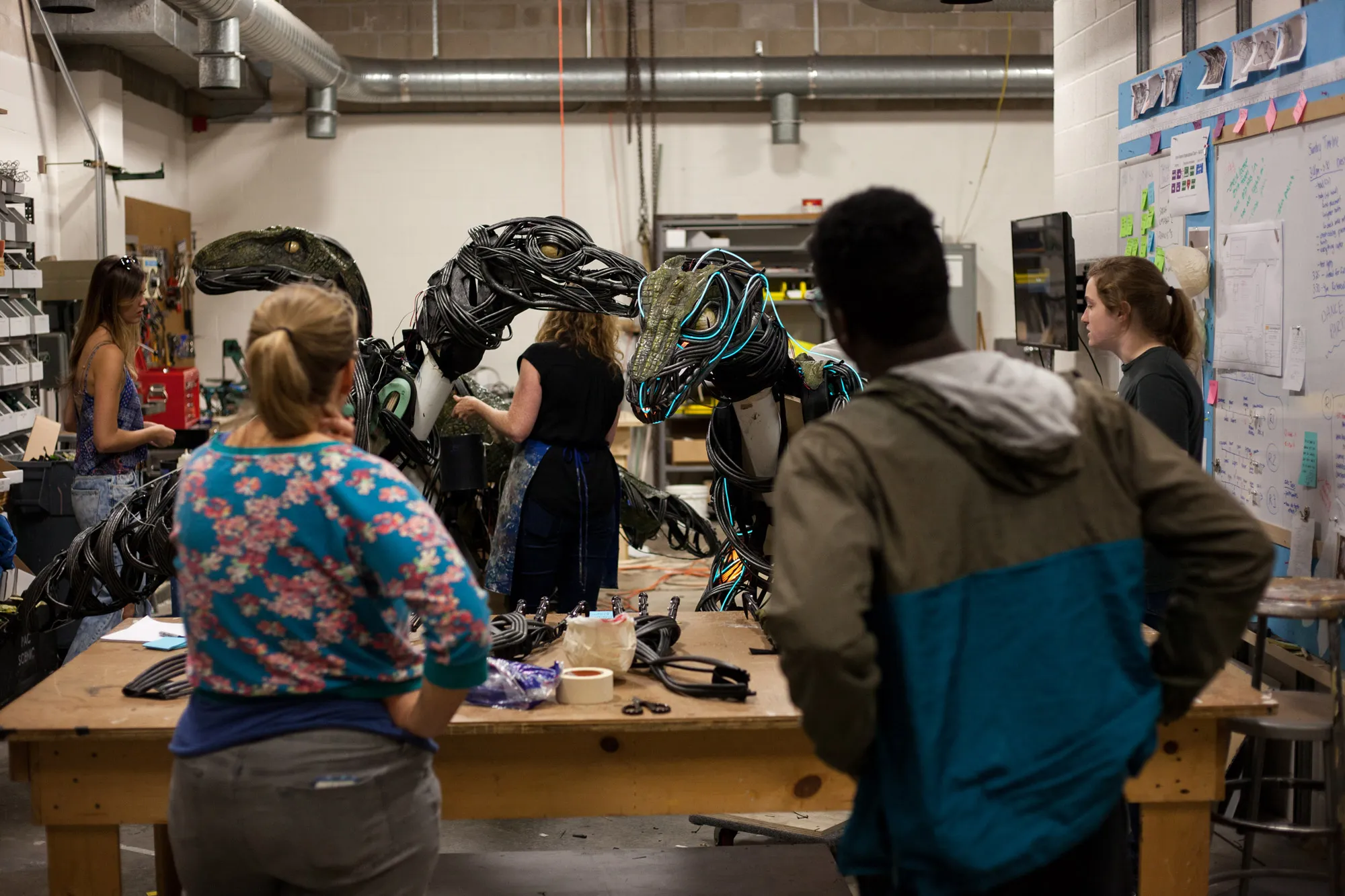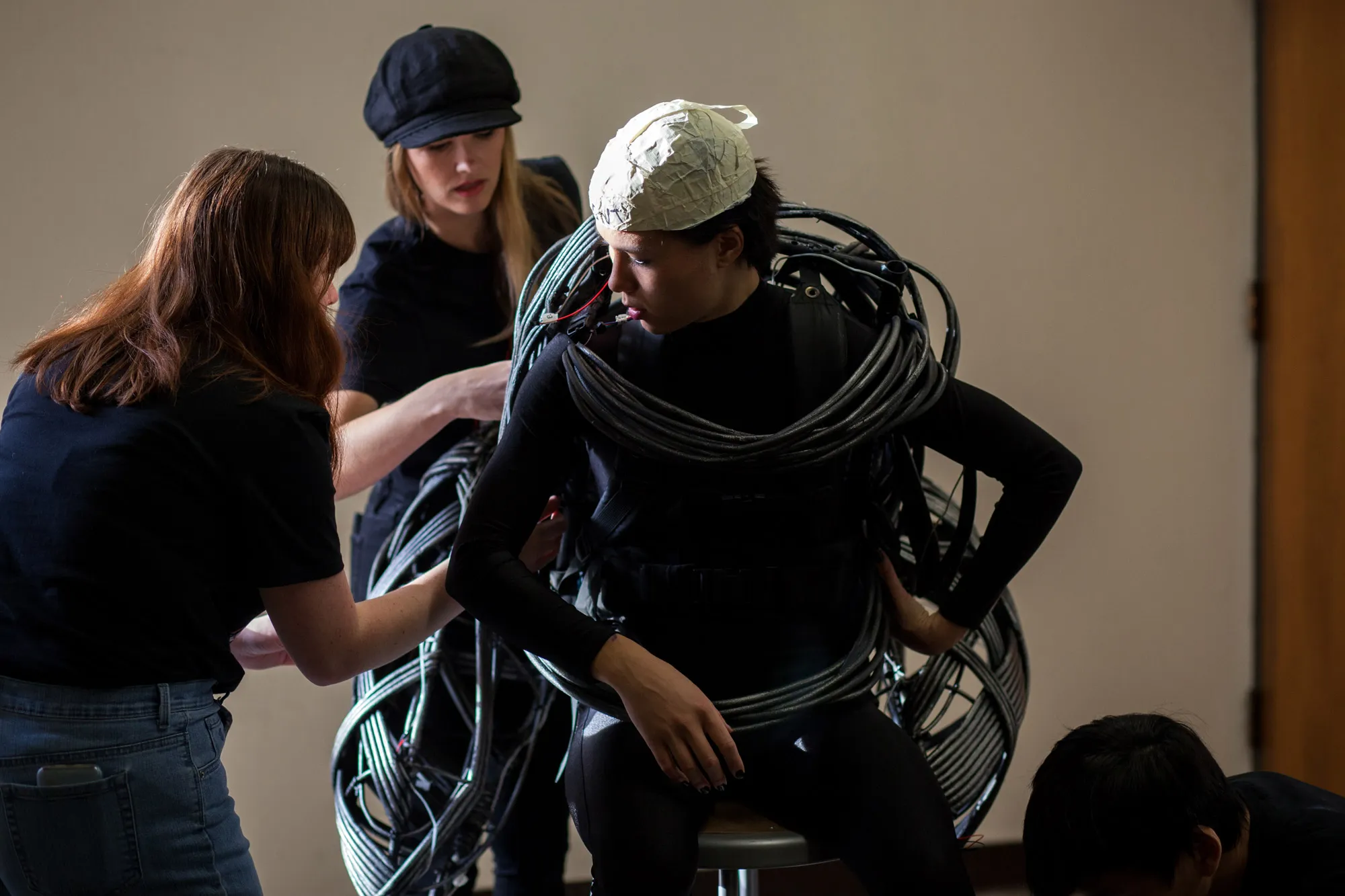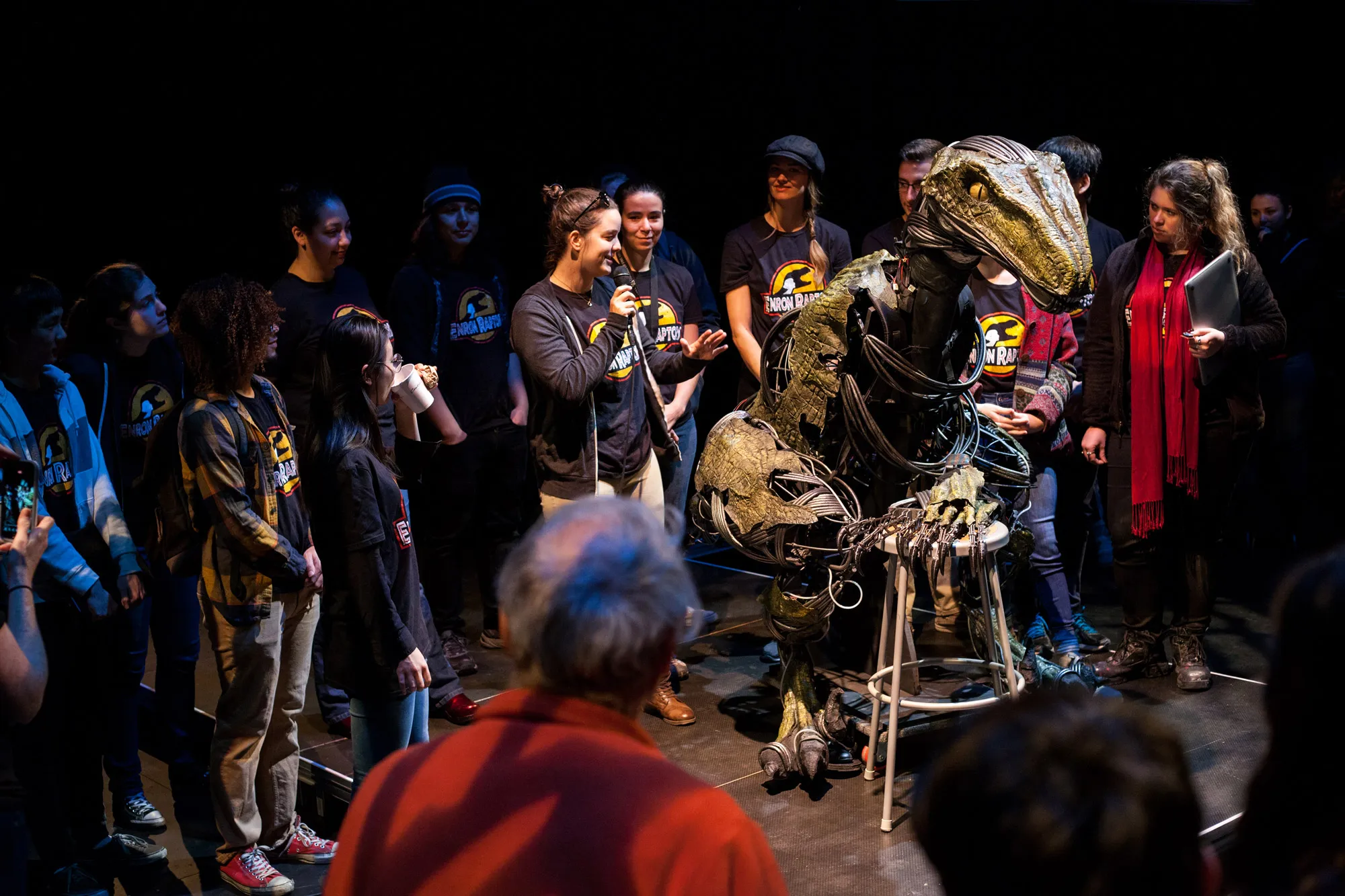Jurassic Quest: Students combine design, science and technology to build animatronic raptor suits for the play Enron

By Rose L. Thayer / Photos by Lawrence Peart
For most college students, there is that one class or project that changes the scope of their career goals. Whether they learn they love something, or maybe don’t love what they imagined they would, these experiences are what define aspirations and inspire lifelong dedication to a craft.
For costume technology graduate student Delena Bradley, that project was creating functioning velociraptor hands.
“My game plan has widened,” she said. “It’s the ability to make something from scratch and use new ways to do it. I still love the idea of building a character with material, but now I’m realizing this doesn’t have to be as traditional.”
Bradley was part of an independent studies course last fall that designed and built three raptors for the Department of Theatre and Dance’s spring production of the play Enron. Part robot, part costume, the raptors help tell the true story of the fall of the Houston-based Enron Corporation.
“I can’t imagine any other place where this thing could happen,” said Bradley, adding that part of the reason she chose the University of Texas for her master’s degree was because of these out-of-the-box opportunities.
The 15 students in the course were taught by Karen Maness, a Department of Theatre and Dance lecturer and Texas Performing Arts scenic art supervisor, and J.E. Johnson, also a lecturer with the Department of Theatre and Dance and scenic studio supervisor for Texas Performing Arts. The students were split into teams, with some students, like Bradley, focused on the hands while others worked on lighting, the body, the skin or the legs.

“We are trying to stay out of the position of expert and let them be the experts,” Johnson said. Because of that, the final products ended up different than he imagined. “Honestly, that’s the goal, because then we know we’ve achieved our goal in that the students have truly come up with the work and not just followed directions. We had no idea we would use the materials we used, and it’s been a great series of surprises.”
The course functioned more like a design lab than a traditional college course. Each week, the students met for class in a repurposed storage space in the backstage area of Bass Concert Hall known as “The Hatchery.” The walls were lined with tools, drawings and progress timelines, leading to the big reveal at the end of the semester. Students were required to document their progress in a blog and commit 10 hours every week (though most did more) to prepare for their latest prototype, due each Monday.
“It’s critical for students to speak effectively about their work, intention, research methods and process,” said Maness. “The blog was created to develop these skills and position our students as artists and makers in the wider community. Connecting them with industry leaders and future employment is paramount among our objectives.”
Most weeks, a guest artist visited to share their work to inform and grow students’ concepts and ideas to further progress on the raptors. Doreen Lorenzo, assistant dean of the School of Design and Creative Technologies and design industry leader, met with students to discuss how to take a prototype to final product. Guest artists included costume professional Zoë Morsette, puppet and materials expert Joe Rial and Ben Bays, lecturer in the Moody College of Communications’ Department of Radio-Television-Film (RTF). Bays' expertise is in animation, motion graphics, concept art and CG models for a variety of media, including television, feature films and video games.
“When Karen told me about the raptor project, she was using the same vocabulary, the same ideas of iteration and development we use for games, for animation, for visual effects, but it was all so...REAL,” said Bays. “It immediately created this new angle on understanding something I was already familiar with. I had to know more.”


Though he mostly works on creating CGI and digital characters, Bays said meeting the students and hearing them discuss concepts to apply skin, create joints and optimize functionality on the raptors was like “hearing a dialect of your own language.”
“The students had this level of technical understanding that I had come to through digital media,” he said.
While Bays brought in techniques from RTF, the students in the class also brought skills from majors outside the College of Fine Arts, inspiring a truly collaborative process. Johnson and Maness said the only prerequisite for the class was 100 percent commitment to the project and having the hours available to do it.
“We wanted to show that if you put a bunch of committed UT students together with coaching, they are capable of great work,” Johnson said.
As part of the application process for the course, students were asked to describe something they had made that they were proud of. While Bradley submitted a donkey’s head she’d made for a production of A Midsummer Night’s Dream—something somewhat related to raptor-building—second-year electrical engineering student Allegra Thomas touted a game design project from an embedded systems class. These are systems that are designed to do a specific task, so she and a classmate created a version of Donkey Kong and wired together a screen and joystick specifically for playing it.

When Thomas, who has an interest in working on film sets in the future, saw the raptor course description online, she immediately thought it would be a great opportunity to put her new embedded system skills to work.
“Also, I’ll never get another chance to make velociraptor suits in my life, so I thought I can’t afford to pass up this opportunity,” Thomas said. She was part of the team that created lighting within the raptor suit and programmed computers to run it. Learning to program wireless systems was the biggest challenge, she said.
Unlike her engineering courses where a strict outline defines what the end result of a project should be, creating the raptors was more freeform.
“There was more experimenting and researching and adapting plans. It’s not as cut and dry. But as far as the technical things go, I have been able to apply some skills learned in that class,” Thomas said.

Bradley agreed that the class really gave room for experimentation, and, more importantly, for mistakes. By using an “I like/I wish/I wonder” form of communication, she said Maness and Johnson really created a space for constructive criticism.
“J.E. talks about failure a lot—I’ve taken to that,” Bradley said. “If you give it the time and space to happen, it’s a positive learning experience.”
For example, the hands of the raptors went through several iterations before they learned the best way to give the actor in the costume the ability to make them move. In the end, the raptors hands were built on leather gloves with thimbles in the fingers, which really allowed the actors to grip and move the dinosaur’s fingers.

Bays described what he saw in the class as “emergent pedagogy.”
“Karen and J.E. had a very clear vision of what was possible, and they just dropped these elegant, perfect disruptions right into it,” he said. “I arrived mere moments after a sea change, engaged with a group of students on a level that is hard to describe, then went back to RTF and started integrating their ideas into my CGI courses. That level of cross pollination from a single visit is a testament to what Fine Arts is up to.
“With so much of the media conversation about digital augmentation, we are forgetting that mixed realities are going to require new physical innovations. This course is building disruptors no one is expecting yet.”
In the future, Johnson and Maness hope to create more classes that solve problems or needs within the college. In most other productions of Enron, the raptors are actors in business suits with dinosaur heads. Graduate student director Hannah Wolf wanted more than that, Johnson said. The students wanted something less silly and more scary.
“The trick is to find projects that are needed in the college. This was solving a specific problem. We need to be good problem finders, and now we have another tool, another method, to solve problems that we find,” Johnson said. “That’s part of what being an entrepreneur is—being a problem finder. We want to find problems, then help students be engaged in those problems and solve them. It’s not just classwork.”
Maness agrees. “Our class established a model of what is possible when resources of facilities, funding, teachers and student populations are pooled together through this reimagined curricular experience. It revealed a glimpse into the power and relevance of fully integrating arts, science and technology, and the potential of future projects to come.”

